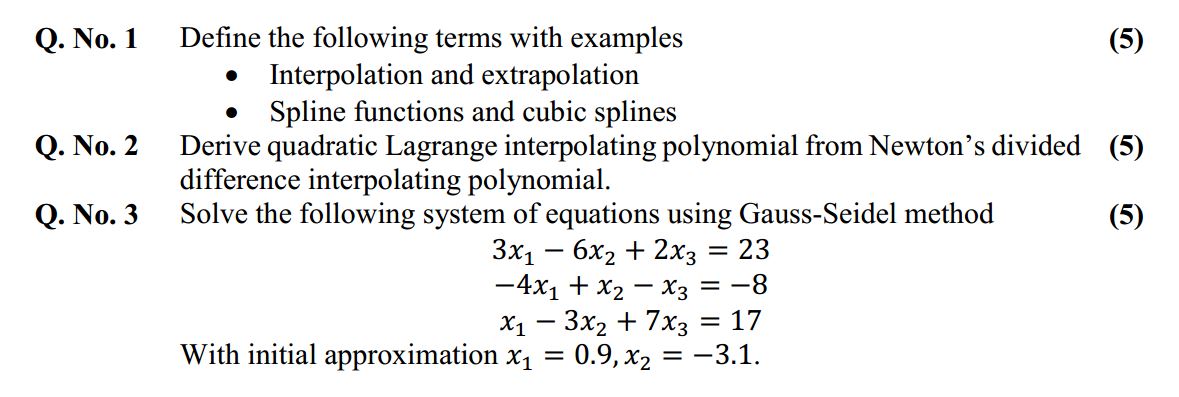Numerical Computing all previous/ past question papers
– Numerical Computing-Computer Science all subject past paper Numerical Computing –Computer Graphics Course Numerical Computing Project idea – ICT MCQ -Numerical Computing Interview Question –Computer Science all courses -Technology –University Past Paper -Programming language –Question paper –old paper
Numerical Computing Fall 21 past paper

Numerical computing final paper
1. Solve the following system using Jacobi method (with 4 digu roues arithmetic, at least). Assume the error tolerance as 0.0001.
15x₁-2X2-6Xj+0x₁ -2x)+12×2-4X3-X4=300
0 -6×1-4×2+19×3-9×4 =0
0x1-X2-9X3+21x₁=0
(Marks 10)
2. Obtain the first and second derivative at x-7 using Stirling formula. Where
Xp= 12
X
5
6
7
8
9
10
f(x)
196
394
686
1090
1624
2306
(Marks-10)
x
3. Use the table in Question no. 2 of values by Newton forward differentiation formula. To compute f (0.25), (0.50), (0.75).
2125 (Marks= 15)
4. Use Question no. lequations, to find X1, X2, X3, and x, values using Gauss
Jordan Elimination Method.
(Marks 10)
5. Compute ff(x) dx based on Trapezoidal rule. 0.6
X
0
0.1
0.2
0.3
0.4
0.5
0.6
f(x)
0
0.0998
0.1987 0.2955 0.38994
0.4794
0.5646
(Marks-05)
Numerical Computing Mid term paper
Q1:
Find the Error if found then remove that error?
| x | F(x) |
| 2.5 | 24.145 |
| 2.0 | 22.043 |
| 2.5 | 20.225 |
| 2.5 | 18.644 |
| 2.2 | 17.262 |
| 3.0 | 16.047 |
Q2:
Find the approximate value of following integral for step, h = 0.25
Over the interval [3,9] where f(x) = x/x+3.
- Composite Bool’s rule
- Composite Weddle’s rule
Q3:
Construct the Newton’s Forward difference interpolating polynomial passing through the points (-1,-3), (1, 5), (3, 17), and (5, 21).
paper 2
Q1:
It is suspected that there is an error in one of the values of f(x) in the following table:
| X | 0 | 1 | 2 | 3 | 4 | 5 | 6 | 7 | 8 | 9 | 10 |
| f(x) | 0 | 2 | 20 | 90 | 272 | 605 | 1332 | 2450 | 4160 | 6642 | 10100 |
Construct the differences-table, detect and correct the error.
Q2:

Q3:
The following table represents the time x and the corresponding velocity f(x) of the particle moving with non-uniform velocity.
| X | 0.0 | 1.0 | 1.5 | 2.0 |
| f(x) | 2.5 | 1.0 | 4.6 | 5.3 |
From this table, using Lagrange’s formula inversely, determine the time when the velocity of the particle becomes 2.75.
Numerical Computing Sessional 1 question paper
Numerical Computing Sessional 2 question paper
- Filling the blanks (Score: 2 5=10)
(1) Let ξ=g(ξ)∈[a, b] be a fixed point of the real-valued and continuous function g(x). If g(x) has a continuous derivative in some neighborhood of ξ with ________.
Then the sequence (xk) defined by xk+1=g(xk) converges to ξ as k→∞, provided that x0 is sufficiently close to ξ.
(2) Assume that .Let be distinct real numbers and suppose that are real numbers. Then, there exists a unique Lagrange polynomial such that ____________.
(3) Suppose that a real-valued function g(x) has a fixed point ξ in [a, b]. Then, the corresponding expression can be written as________.
(4) Given that 4x2-a=0, where a is positive real number. Then, the iteration for solving this equation by the secant method can be expressed as ____________with x0 and x1 being the starting values.
(5) During the process of finding the single solution to the equation f(x) =0 in [a0, b0] with f(a0)f(b0)<0, the first step is to consider the midpoint . If (the given tolerance), then we need to choose the new interval:[a1, b1]=[a0, c0] in the case of _____;or [a1, b1]=[c0, b0] in the case of _____.
- Find solution using Bessel’s formula Score= 10
- Find Solution using Newton’s Backward Difference formula Score=10
| x | f(x) |
| 3.5 | 34.145 |
| 4.0 | 32.043 |
| 4.5 | 30.225 |
| 5.0 | 28.644 |
| 5.5 | 27.262 |
| 6.0 | 26.047 |
x = 4.75
Numerical Computing Final question paper
- MCQ’s (Marks=10)
- How much significant digits in this number 204.020050?
- 5
- 7
- How much significant digits in this number 204.020050?
- 9
- 11
- In which of the following method, we approximate the curve of solution by the tangent in each interval.
- Hermite’s method
- Euler’s method
- Newton’s method
- Lagrange’s method
- When do we apply Lagrange’s interpolation?
- Evenly spaced
- Unevenly spaced
- Both
- None of above
- When Newton’s backward formula is used?
- To interpolate values
- To calculate difference
- To find approximate error
- None of above
- What are the errors in Trapezoidal rule of numerical integration?
- E<Y
- E>Y
- E=Y
- None of above
- Consider the initial value problem; give the condition of the absolute stability for the Euler method. (Marks= 10)

- Suppose that the function values of f(x) are given in the following table.
| X | -1 | 1 | 2 |
| ln X | -3 | 0 | 4 |
(Marks= 10)
Find the approximate function value at the point by the Lagrange’s interpolation polynomial of degree 2.
- Use the predictor-corrector method to get the approximate solution of the following initial value problem (Marks= 10)
 with h = 0.1, 0 < x < 0.5.
with h = 0.1, 0 < x < 0.5.
- Consider the function f(x) = cos x−x=0. Approximate a root of f(x) via Newton’s Method. (Marks= 10)
Numerical Computing Final Paper 2022


#Numerical Computing #Computer Science all subject past paper Numerical Computing #Computer Graphics Course #Numerical Computing Project idea #Numerical Computing MCQ #Numerical Computing Interview Question #Computer Science all courses #Technology #University Past Paper #Programming language #Question paper #old paper

